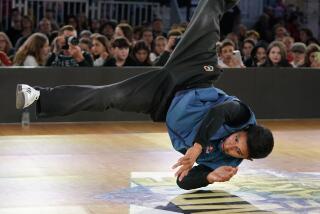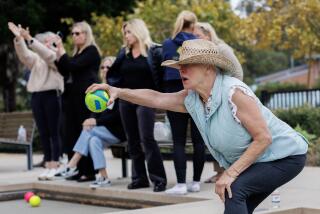Roll With the Punches : What to the Unobservant Seems Like a Big Yawn on the Lawn Has Participants Bowled Over When Going for the Big Spin
- Share via
Lawn bowling.
The mention of “bowls,” as the game is known among its devotees, invariably invokes humorous images of elves bowling on the green or retirement home patrons shuffling away an afternoon. But now that the chuckles are out of the way, settle down for some serious stuff.
“It’s the hardest game I’ve ever played, other than golf,” says Nick Christensen of Sonoma, Calif. “Most younger people see older people playing it and think, well, it’s not that competitive, and it can’t be that tough because they’re older. But it’s not a physically aggressive game. It’s a mind game.”
Merton Isaacman of Irvine says: “In international tournaments the tension is unbelievable.”
Lawn bowling combines the skills and attitudes of other sports from the sedate side of the scale, such as golf, billiards, chess--and, of course, bowling. But it’s more physical than billiards and chess, more tactical than bowling and more aggravating than golf, where one can let off steam by throwing a club.
Lawn bowlers don’t behave that way. The customary emotion expressed during the American Lawn Bowls Assn. National Open tournament this week is, from one participant to another, “Nice bowl.” Their teeth may be clenched when they say it, but they say it. They curse only themselves, as Isaacman vented his frustration to himself: “How stupid can you get!”
Competition concluding Saturday is on eight greens--six in Orange County, one in Riverside and one in Long Beach at Recreation Park. There are 276 men and 160 women participating in singles, pairs, triples and “rinks,” the last with four women to a team.
And they all don’t answer to “Grandpa” or “Grandma” anymore.
Laird McDonald of Camarillo, the 1988 U.S. singles champion, was 10 years old when he started. “I wasn’t very popular,” he said. “They were trying to encourage younger people, and they weren’t used to it. It was an older person’s sport.”
That is changing. World champions are in their 20s. England, with 300,000 participants, has under-10 leagues--Little League lawn bowling. Among current top U.S. competitors, Christensen and McDonald are 42, Isaacman 45--although the national singles title went to Neil McInnes, 65, of Glendale last weekend. McInnes has been one of five members of the last four U.S. teams in the World Championships, which are held in Olympic years.
Lawn bowling involves a minimum of understanding and a maximum of aggravation. In singles, each player has four balls, called “bowls,” made of plastic-like phenolformaldehyde. Each weighs no more than 3 pounds 10 ounces, according to the rules book. They are slightly flat on one side, which makes them impossible to roll straight. But they can be rolled either “forehand” or “backhand” on their sides and thus made to curve either left or right as they start to lose velocity and lean to the heavy side.
There also is a small white ball about the size of a cue ball called the “jack.” One player will roll this toward the other end of the 120- to 132-foot lane, or “rink,” as the target for an “end.” An end is one round of each player rolling all his bowls. There is a gutter at the end to arrest overpowered bowls--as in Isaacman’s vernacular, “That’s in the bloody ditch!”
Only one player scores in each end. Each bowl closer to the jack than any of the opponent’s bowls counts one point--thus, the maximum score in one end is four. It’s common for one player to have bowls in position for, say, three points, then have his opponent take the end, 1-0, by rolling his last bowl inside the group.
That’s where the aggravation comes in. People get all worked up over this, especially in Britain and the Commonwealths. Edna Chadwick, a visitor from Wahroonga, Australia, near Sydney, was in Long Beach to root for her friend, John Wills.
“I’m a professional spectator,” she said.
She was the only spectator.
“For the Australian nationals, they’d have stands up,” Wills said. “It’s a spectator sport there. The finals would be televised.”
There also are about 600,000 players in Australia--that’s more than one in every six citizens--compared to 20,000 in the U.S., with nearly half in California.
In England or in South Africa, where Isaacman learned the game, the dress code also is strict. That is, everybody was wearing white clothing at Long Beach, but some were wearing shorts and white Reeboks.
“You won’t get a person coming onto a green in the wrong shoes--anything other than bowls shoes,” Isaacman said. “Absolutely smooth on the bottom. They also dress correctly. The Americans do not dress correctly.”
Edna said: “You can wear shorts in the summer--provided you wear long white socks.”
The greens also are better. Most players in Long Beach were muttering about grass clippings sticking to their bowls from the morning dew, which also made the greens unsatisfactorily slow.
“The faster the green, the more I like it,” McDonald said. “Australia has the best greens in the world . . . anywhere from 16 to 21 seconds. The longer it takes your bowl to get to the jack, the faster the facilities are. These are probably 8 or 9 seconds. It takes a lot of the skill out of the game.
“But these will speed up all day long, and after bowling on them for three or four days they’ll get very fast.”
Not soon enough for McDonald and Isaacman, who were eliminated in the second round.
“You smile because you don’t want to look like a (jerk),” Isaacman said after his first match, which he won. “But, in all honesty, it is tense. These guys’ll talk to you all day long and try to get your mind going elsewhere.
“This guy was talking to me about rolling the green and the greenkeeper and how the grass would come up on the balls . . . all different things, trying to break my concentration. Concentration is 90% of this game.”
McDonald, who lost a tough match to Christensen, 18-14, said, “If you play well, you don’t mind losing. It’s when you’re not bowling well, like golf, that it starts to get to you mentally.”
The situation can change completely on any roll.
“The thing about lawn bowling that makes it different from other sports is the variables involved,” Christensen said. “You can’t depend on anything except getting as close as you can, and if you don’t get as close as you can, then you have (to play for) position. Every bowl is different.
“Touch is the main thing. Some guys have it, some don’t. You can’t teach touch. I played a lot of basketball. Good basketball players have touch. That’s what separates the top from the rest.”
As in golf, touch tells a good player whether he has made a good shot as soon as he releases the bowl.
“Right away,” Christensen said. “You can feel it. How much do you take off? How much do you put on? You don’t know. It’s like Michael Jordan trying to explain some of the moves he makes. It’s just a feeling.”
The history of lawn bowling is vague. Some say it originated in ancient Egypt, others in Rome as bocci, which is still played by Italians but was refined in England with formation of the Southhampton Old Bowling Green Club in 1299. It came to the American colonies in the 1600s.
McDonald’s bowls are older than he is.
“They were made by Brunswick just before World War II broke out,” he said.
The first West Coast green was built in San Francisco’s Golden Gate Park in 1899, and Fred Robinson of Long Beach claims to have seen it played on greens in the Arroyo Seco during the 1932 Olympics, although Olympic records don’t mention it.
Well . . . Robinson thinks it should be an Olympic sport.
“If Ping-Pong is in, why not lawn bowling?” he reasons.
The American Lawn Bowling Assn. Nationals are being contested this week at Laguna Beach Lawn Bowling Club, Costa Del Sol LBC in Mission Viejo, Newport Harbor LBC in Corona del Mar, Santa Ana LBC, The Meadows LBC and The Groves LBC in Irvine, Riverside LBC and Recreation Park in Long Beach.
More to Read
Go beyond the scoreboard
Get the latest on L.A.'s teams in the daily Sports Report newsletter.
You may occasionally receive promotional content from the Los Angeles Times.










